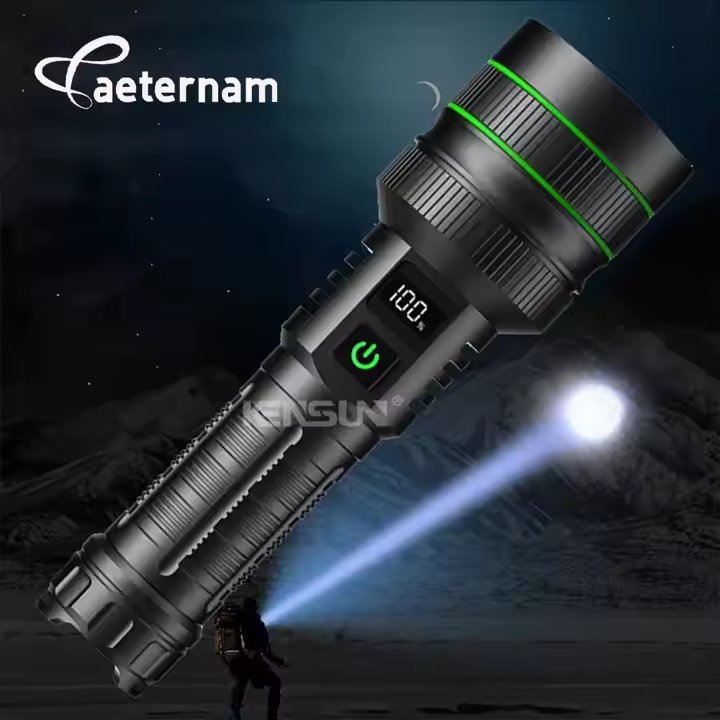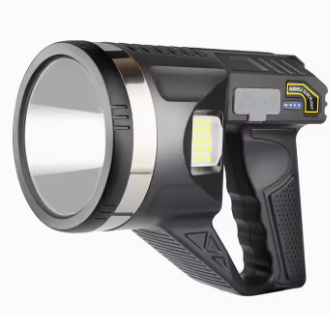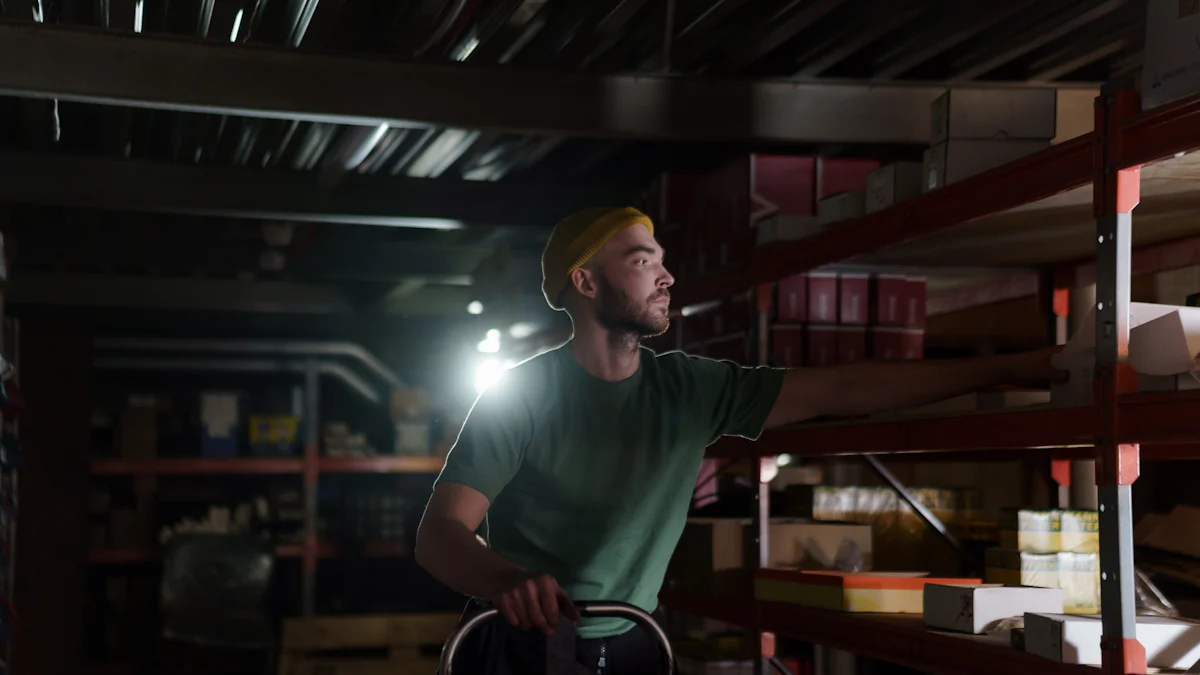Why Headlamps are Ideal for Nighttime Construction Work

Nighttime construction comes with its own set of challenges, and this is exactly why headlamps are ideal for nighttime construction work. You’ve probably noticed how reduced visibility can make even simple tasks feel more complicated. Fatigue often sets in faster when you’re straining to see clearly. That’s where a headlamp becomes your best ally. It provides focused lighting right where you need it, helping you navigate tricky areas and complete detailed work with ease.
Low visibility isn’t just inconvenient—it’s a major safety risk. Accidents happen when workers can’t see hazards in time. A headlamp improves nighttime safety by lighting up your path and surroundings. It’s portable, hands-free, and boosts efficiency, making it an essential tool for nighttime construction. Whether you’re working or walking at night, headlamps ensure you stay safe and productive, highlighting why headlamps are ideal for nighttime construction work.
Key Takeaways
Headlamps let workers use both hands while working. This helps them stay focused and work safely on construction sites.
Seeing clearly is very important at night. Headlamps can change brightness and beam settings to match different tasks.
Headlamps make work safer by lowering the chance of accidents. They help workers see dangers early and move safely in the dark.
Headlamps are better than flashlights or vehicle lights. They are easy to carry, give steady light, and move with you.
Comfort matters during long work hours. Pick headlamps with straps you can adjust and padding for a good fit and fewer distractions.
Key Benefits of Headlamps for Nighttime Construction

Hands-Free Operation
Imagine trying to hold a flashlight while operating heavy machinery or handling tools. It’s not just inconvenient—it’s unsafe. That’s where headlamps shine. They free up your hands, letting you focus entirely on the task at hand. This hands-free operation boosts efficiency in nighttime construction. You can communicate with your team using voice commands without fumbling with a device. It’s especially helpful in hazardous environments where every second counts. Equipment operators benefit the most, as they can work without interruptions, reducing idle time and improving worker safety.
Headlamps also make tasks like climbing ladders or navigating confined spaces easier. You don’t have to worry about dropping a flashlight or losing your grip. With both hands available, you can work faster and safer, making headlamps an essential tool for nighttime construction.
Enhanced Visibility for Nighttime Construction
Poor visibility is one of the biggest challenges you face during nighttime construction. Headlamps tackle this issue head-on by providing focused lighting exactly where you need it. Modern headlamps often use LED bulbs, which are energy-efficient and incredibly bright. You can choose between flood beams for wide coverage or spot beams for precise lighting. Some headlamps even offer downcast LEDs to illuminate the area below you, perfect for tasks requiring close attention.
Need to maintain your night vision? Many headlamps come with red light settings. Plus, adjustable brightness modes let you adapt to different tasks, whether you’re working on detailed wiring or scanning a larger area. This versatility ensures you always have the right amount of light, improving both visibility and efficiency.
Improved Construction Site Safety Lighting
Safety should always come first, especially on a construction site. Headlamps play a crucial role in construction site safety lighting. They help you move safely through low-light areas, reducing the risk of trips and falls. In confined spaces, proper lighting can prevent serious accidents. Studies even show that using headlamps can decrease accidents related to poor visibility by 30%. That’s a huge improvement for worker safety.
Headlamps also let you operate machinery or tools without holding a flashlight, minimizing the risk of losing control. With better lighting, you can spot hazards earlier and react faster. This not only keeps you safe but also boosts productivity by reducing downtime caused by injuries. Whether you’re working or using headlamps for walking at night, they’re a must-have for staying safe and efficient.
Why Headlamps Outperform Other Lighting Solutions
Stationary Lighting vs. Headlamps
Stationary lighting can seem like a good option for nighttime construction. But it has its limits. These lights stay fixed in one spot, which means they can’t adapt to your movements. If you’re working in a large area or moving between tasks, stationary lighting often leaves parts of the site in shadows. This creates zones of inadequate lighting, which can lead to accidents or missed details.
Headlamps solve this problem by moving with you. Wherever you look, the light follows. This ensures consistent visibility, no matter where you are. You don’t have to stop and adjust a light source or worry about dark corners. Plus, headlamps are portable. You can take them anywhere on the site, making them a more flexible and efficient choice for construction site safety lighting.
Handheld Flashlights vs. Headlamps
Handheld flashlights are another common tool for nighttime construction. But let’s be honest—they’re not the most practical. Holding a flashlight ties up one of your hands, which can slow you down. Imagine trying to use tools or climb a ladder while juggling a flashlight. It’s frustrating and unsafe.
Headlamps, on the other hand, keep your hands free. This makes tasks easier and safer. You can focus on your work without worrying about dropping a flashlight. Headlamps also provide steadier lighting since they stay in place on your head. This stability improves visibility and reduces the strain of constantly readjusting your light source. For workers who need both hands on the job, headlamps are the clear winner.
Vehicle-Mounted Lights vs. Headlamps
Vehicle-mounted lights are powerful, but they come with challenges. Glare from these lights can temporarily blind workers or passing motorists. You also need to position them carefully to avoid creating shadows. Even with proper setup, vehicle-mounted lights often fail to provide adequate illumination for detailed tasks. In many cases, you’ll need extra lighting to fill in the gaps.
Headlamps eliminate these issues. They offer focused, personal lighting that doesn’t rely on vehicle placement. You can adjust the beam to suit your needs, whether you’re inspecting machinery or navigating tight spaces. Headlamps also reduce glare and improve safety by providing consistent, close-range lighting. For tasks requiring precision and mobility, headlamps outperform vehicle-mounted lights every time.
Choosing the Best Headlamp for Nighttime Construction

Brightness and Beam Distance
When choosing a headlamp for nighttime construction, brightness and beam distance are two of the most important factors. Brightness, measured in lumens, determines how much light the headlamp produces. For construction tasks, you’ll want a headlamp with 300 to 700 lumens for detailed work in dark areas. If you’re working in extremely dark conditions or need to spot objects far away, go for a headlamp with 800 lumens or more.
Beam distance, on the other hand, tells you how far the light will travel before it fades to the brightness of moonlight. This feature is crucial for different tasks. For close-up work like inspecting machinery, a shorter beam distance works just fine. But if you’re navigating rugged terrain or scanning a large area, a longer beam distance is essential. Many headlamps let you switch between flood and spot beams, giving you flexibility for various construction scenarios.
Battery Life and Power Options
Battery life can make or break your headlamp’s performance. Rechargeable headlamps are a popular choice because they’re cost-effective and eco-friendly. On high settings, they typically last 3–4 hours, while lower settings can stretch up to 10–15 hours. If you prefer disposable batteries, they often last longer but require frequent replacements, which can add up over time.
LED headlamps are a smart pick for construction work. They’re energy-efficient and offer longer runtimes compared to traditional bulbs. Plus, they’re perfect for extended tasks where consistent lighting is key. Always check the battery indicator on your headlamp to avoid running out of power in the middle of a job. A backup power source is also a good idea for added reliability.
Durability and Weather Resistance
Construction sites can be tough on equipment, so your headlamp needs to be just as tough. Look for a robust build that can handle physical abuse, like drops or impacts. A cylindrical design with rubber knobs absorbs shocks and eliminates weak points. Large buttons are another must-have, especially if you’re wearing gloves. They make it easy to operate the headlamp in any condition.
Weather resistance is equally important. A waterproof headlamp can handle rainy conditions without breaking down. Resistance to freezing temperatures ensures it works even in the coldest environments. Some headlamps are also designed to withstand sun exposure and falling debris, making them a reliable choice for outdoor construction. These features not only enhance durability but also improve safety and efficiency on the job.
Comfort and Fit for Long Hours
When you’re working long hours on a construction site, comfort isn’t just a luxury—it’s a necessity. A poorly fitting headlamp can cause headaches, pressure points, or constant adjustments, which can distract you and lower your productivity. That’s why choosing a headlamp designed with ergonomic features is so important.
Here’s a quick look at some key ergonomic features that make headlamps more comfortable for extended use:
Ergonomic Feature | Description |
|---|---|
Adjustable Straps | Allow for a custom fit, ensuring the headlamp stays securely in place without causing discomfort. |
Padding | Helps to distribute weight evenly and reduce pressure points. |
Balance | Prevents the headlamp from tipping forward or backward. |
Adjustable straps are a game-changer. They let you customize the fit so the headlamp stays snug without feeling too tight. Padding adds another layer of comfort by spreading the weight evenly across your head. This reduces pressure points, especially during long shifts. Balance is equally important. A well-balanced headlamp won’t tip forward or backward, so you can focus on your work instead of constantly readjusting your lighting.
Fit doesn’t just affect comfort—it impacts usability and safety too. A study by the National Institute for Occupational Safety and Health (NIOSH) found that workers are 85% more likely to use personal protective equipment like headlamps consistently when it’s comfortable. This means a well-fitting headlamp not only keeps you comfortable but also ensures you stay safe and productive throughout your shift.
If you’re using headlamps for walking at night or navigating a construction site, comfort becomes even more critical. A headlamp that fits well allows you to move freely without distractions. It’s one less thing to worry about, so you can focus on the task at hand. When you’re choosing a headlamp, don’t overlook comfort and fit—it’s the key to staying efficient and safe during nighttime construction.
Tips for Effective Use of Headlamps on Construction Sites
Proper Positioning for Optimal Lighting
Getting the most out of your headlamp starts with proper positioning. You want the beam to align with your line of sight, so the light hits exactly where you’re working. Adjust the angle of the headlamp to avoid glare or shadows that could obscure your view. If you’re working on detailed tasks, tilt the beam slightly downward for better focus. For broader visibility, like navigating a site, aim the beam straight ahead.
Don’t forget to test the lighting in different conditions. Construction sites often have uneven surfaces or reflective materials that can affect how the light behaves. A quick adjustment can make all the difference in ensuring you see clearly and stay safe. Proper positioning not only improves visibility but also reduces eye strain during long shifts.
Maintenance and Care for Longevity
Taking care of your headlamp ensures it performs well over time. Regular maintenance is key. Start by cleaning the lens monthly with a soft cloth and mild soap to remove dirt and debris. Avoid harsh chemicals that could damage the lens coating. Check for cracks or moisture inside the housing, as these can lead to reduced lighting or even electrical issues. If you spot any damage, address it immediately to prevent further problems.
Protective treatments can also extend your headlamp’s lifespan. Use UV-resistant sealants to prevent the lens from yellowing or clouding. For added durability, consider professional coatings that shield against environmental wear and tear. Routine inspections and cleaning not only keep your headlamp in top shape but also ensure consistent lighting performance, which is crucial for nighttime construction.
Team Coordination with Headlamps
Headlamps don’t just help you—they’re a game-changer for team coordination. When everyone on the site uses headlamps, communication becomes more efficient. Workers can use their lights to signal directions or alert others to hazards without shouting over noisy equipment. This non-verbal communication reduces misunderstandings and keeps the team on the same page.
Hands-free lighting also allows workers to focus on their tasks without distractions. Whether you’re operating machinery or assisting a teammate, having both hands free minimizes the risk of accidents. Coordinated use of headlamps improves overall site safety and boosts productivity. When everyone works together with proper lighting, the job gets done faster and more efficiently.
Headlamps are a game-changer for nighttime construction. They provide unmatched lighting that moves with you, ensuring you stay safe and productive. Their hands-free operation lets you focus on tasks without distractions, reducing accidents and improving efficiency. With features like robust builds, large buttons, and adaptability to weather, they’re built for tough environments. Plus, they enhance team coordination, making job sites safer for all workers. By choosing the right headlamp and using it effectively, you can tackle nighttime challenges with confidence and ease.
Remember, the right lighting isn’t just a tool—it’s your key to safety and success.
FAQ
What brightness level is best for nighttime construction work?
You’ll want a headlamp with 300–700 lumens for most tasks. For extremely dark areas or long-distance visibility, go for 800 lumens or more. Adjustable brightness modes are a bonus, letting you adapt to different tasks easily.
How do I maintain my headlamp for long-term use?
Clean the lens monthly with a soft cloth and mild soap. Check for cracks or moisture regularly. Avoid harsh chemicals. Use UV-resistant treatments to prevent lens yellowing. Routine care ensures your headlamp stays reliable and performs well over time.
Can I use rechargeable batteries for my headlamp?
Yes, rechargeable batteries are a great choice. They’re eco-friendly and cost-effective. Most last 3–4 hours on high settings and up to 15 hours on low. Always keep a backup power source handy to avoid interruptions during work.
Are headlamps comfortable for long shifts?
Modern headlamps are designed for comfort. Look for adjustable straps, padding, and balanced designs. These features prevent pressure points and ensure a snug fit. A comfortable headlamp keeps you focused and productive, even during extended hours.
Do headlamps work in bad weather?
Absolutely! Many headlamps are waterproof and weather-resistant. They can handle rain, freezing temperatures, and even falling debris. Check for an IPX rating to ensure your headlamp is built for tough outdoor conditions.
💡 Tip: Always choose a headlamp with durability features if you’re working in harsh environments. It’s worth the investment!
See Also
How to Choose the Ideal Flashlight or Headlamp for Outdoors
Five Essential Tips for Selecting Headlamps for Wholesale Sales
Why Finding Trustworthy Suppliers for Medical Headlamps Matters
Key Advice for Choosing a Reliable Wholesale Headlamp Provider
Strategies for Locating the Most Reliable Headlamp Suppliers
About US
Follow Us
Hello,Friend,
I am Mary from Helius, we are manufacturer of LED lighting products with more than a decade of experiences.
We offer hot selling products in market and guarantee the quality with competitive cost.
Let’s have more discussion on your inquiry.
Or you can reach out me via what’s up/tele gram +8618123952945 if it’s favorable to you.
Address
4th Floor, Building A16, Intelligent terminal industrial park of Silicon Valley, Dafu Industrial Zone,Guanlan, Shenzhen, 518110 China
Contacts
mary@heliuslights.com
heliuslight04@hotmail.com
+0086 18123952945
